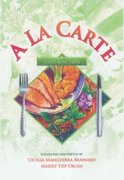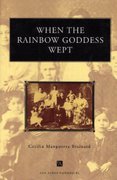The trip to Arrowhead was great! Activities consisted of non-stop talking, eating, praying, shopping, and watching August Moon. It was still very cold in Arrowhead - remember, we are all Tropical girls! There was still snow along the banks. It rained Saturday night and there was a flurry on Sunday.
We had a lot of Filipino comfort foods: Sinigang, Binagoongan, fried dilis,longaniza, plus other dishes. Maria Ciocon brought a wonderful Corn Soup, and below is her recipe. I've asked the others for their recipes, which I'll add to this blog entry:
Maria Ciocon's CORN SOUP
Here again is the basic- the soup I cooked Saturday was - 3 small cans of
cream corn (salted) and also 2 or 3 chicken broth. Start with 2 if you put
3 might get too watery and not as creamy.
1. chicken breast-boiled and diced into serving pieces (your sahog can
also be shrimp, artificial crab or ground pork
2. sauté garlic, onion, with cooked chicken breast. Add a little
Fish sauce for flavoring.
3. add 2-3 cans of cream corn. Stir for 2-3 minutes allowing corn
to mix with your chicken. Then add your chicken broth. Low to medium
fire, when your soup is boiling put 1-2 eggs and whisk fast. This will
make the soup thick in consistency.
Soup I cooked was good for 2 meals It will last and still be OK
for 2-3 days as long as its refrigerated.
Maria Ciocon's LAING
Your gabi leaves should really be dry cause if not you throat will get itchy.
Cut gabi leaves. Your sahog will be shrimps, dried fish (daing) pieces of pork w fat so to make it tasty. Don’t use beef, it will not give it flavor. Sliver of ginger and little garlic. I don’t think you use onions.
1 can of coconut milk or two depending on amount of gabi leaves
Bagoong (shrimp paste)
chili-small red or green ones, depend on how hot or spicy you want it to be.
1. saute your ginger , garlic,
2. add your pork, shrimp or daing or all 3 to make if you want it really tasty
3. add your leaves
4. pour your coconut milk, not the top or creamy portion. (do not dilute your coconut milk with water)
5. season with bagoong, and when leaves are wilted or look more or less like pureed, add creamy portion of coconut milk
6. when ready to serve add chili, cause if you put this early it will really be spicy
Your dish should look like spinach deep with a little oil from coconut oil, it shouldn’t look watery.
Or since this is a poor man’s dish you can just put all of the above together,let it boil. When creamy (like a spinach deep) add your creamy part of the coconut milk. Add or season with bagoong and add your chilis
~~~
Meldee Perez's SINIGANG NA BABOY Ingredients: cooking oil, pork neck bones cut into
serving pieces (you can also use pork ribs), garlic,
onions, tomatoes, rice water, patis, 1 green or yellow
chili, Knorr tamarind soup base in packet, baby
bokchoy, talong (optional) and white radish
(optional).
For SINIGANG NA HIPPON , just boil tomatoes first in
rice water. Once tomatoes turn soggy and soft, add
slice onions. Add patis and knorr tamarind to taste.
Then add shrimps until cooked. Add bokchoy before
serving. Serve hot.
Saute garlic, onions,in oil then add pork. Brown
pork, then add tomatoes. Saute around 15 to 20
minutes or until you see fat coming out from the pork,
then add little patis for the pork to absorb the
patis, stir and wait for around 5 minutes. Add rice
water. This is usually the time I cook rice. 1st
wash, I throw, and add the 2nd wash into the pot.
Broth added depends on how much soup you want.
Usually I drown the meat. Let boil until meat is
tender. I remove the fat w/c surfaces on the broth.
You can add water if you think you want more soup.
Put the tamarind powder in a bowl and add water and
stir to blend. (Most of the time, I just add the
tamarind powder directly in the pot when I'm
tinatamad). Add some more patis to taste and blend
w/the tamarind. Add talong, radish and bokchoy and
serve hot.
Meldee Perez's TINOLA
Ingredients: cooking oil, garlic, onions, ginger,
chicken cut in serving pieces and remove skin, patis,
rice water, chayote cut in 2, then cut horizontally,
spinach wash well (optional) or green onions, optional
(cut into 2 inches long) to add green color.
Saute garlic, onion and ginger in oil. When you can
smell the ginger, add cut chicken and brown around 10
to 15 minutes. Add patis generously . Add rice water
and let boil until tender. Remove floating fat.
(marami iyan!) Before the chicken gets too tender,
add chayote w/c cooks like 10 minutes. Add spinach or
green onions before serving. Serve hot.
~~
Read also:
Cooking with Cecilia Brainard - Quiche
Cooking with Cecilia Brainard - Linguine with Clams
Cooking Lengua Estofada
Food Essay - Fried Chicken Caribbean-style
How I Learned to Make Leche Flan (or How I Met my Husband)
Cooking with Cecilia - Leche Flan (Vietnamese Style)
Recipe of Balbacua Cebuana from Louie Nacorda
Easy Filipino Recipes from Maryknollers
Cooking with Cecilia - Beef Bourguignon
Cooking with Cecilia - Chicken Soup for my Bad Cold
tags: food, wine, cooking, recipes, Filipino
































